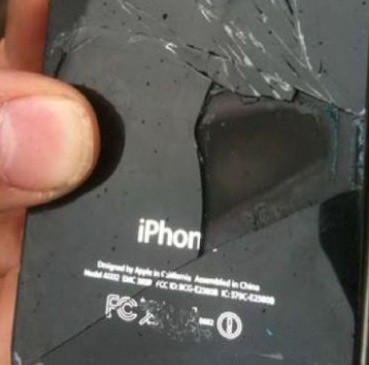Apple iPhone 4 Spontaneously Combusts on Airplane

An Australian regional airline reported Friday that a passenger's iPhone began glowing red and emitting smoke before having to be doused by a fire extinguisher. The incident occurred on a Regional Express flight ZL319 heading from Lismore to Sydney.
The Apple iPhone 4 had partially melted before a flight attendant arrived with the extinguisher and successfully doused the smoking device. No passengers or flight crew were harmed, the airline said.
The Australian Transport Safety Bureau (ATSB) and the Civil Aviation Safety Authority (CASA) are both on the case.
We do have the phone, it's in our custody, and we will be undertaking a technical examination of it, said an ATSB spokesperson.
CASA spokesperson Peter Gibson said the ATSB would strip the iPhone 4 down sometime this week and try to understand what happened. Fiona Martin, the spokeswoman for Apple Australia, says the company is looking forward to working with officials in investigating the incident.
The ATSB says it has no previous records of iPhones undergoing spontaneous self-ignition, but several such cases have occurred with laptops, smartphones and iPhones.
In 2009, reports came pouring in from Europe detailing horrific explosions of Apple devices. In the Netherlands, an iPhone 3G turned bright red, caught fire and burnt a hole through a car seat. In another instance, a French teenager claimed his iPhone cracked up and left a glass shard in his eye. The most similar case to the Regional Express plane incident occurred in Great Britain, where a teenage girl from Liverpool said her iPod Touch exploded after increasing in temperature and hissing violently. The father of the teenage owner said within 30 seconds there was a pop, a big puff of smoke, and [the phone] went 10 feet in the air. The father and daughter left the car as the phone combusted, and returned later to find the car filled with black smoke.
Apple did not admit liability in either of these cases, telling the European Commission that it regarded the explosion cases as isolated incidents with no evidence of a general problem. The company did, however, did offer the teenaged Liverpool owner about a $271 refund, with a caveat that she agree that you will keep the terms and existence of this settlement agreement completely confidential. The Cupertino, Calif.-based company also added that a breach of confidentiality may result in Apple seeking injunctive relief, damages and legal costs against the defaulting persons or parties. The Liverpool owner did not sign the agreement, and thus was not compensated for the incident.
The iPhone 4 is made with a built-in rechargeable lithium-ion battery, which has been known to overheat. In 2006, Sony recalled its lithium-ion batteries in a move that cost the company $429 million. Two years later, Sony again recalled about 100,000 notebook batteries after learning about overheating issues.
The U.S. House of Representatives passed a rule in April that bars the Obama administration from limiting shipments of lithium-ion batteries by air. The proposed rule, put together by the FAA and the Pipeline and Hazardous Materials Safety Administration, noted that 21 out of 44 lithium-ion battery incidents occurred on passenger aircrafts; 16 involved carry-on luggage, and one occurred in checked baggage. The other 23 incidents occurred on cargo aircrafts, presumably where batteries were being shipped in bulk. The rule would have eliminated exceptions for small lithium-ion batteries, classifying all lithium-ion batteries kind as Class 9 hazardous cargo.
Apple's iPhone 4 is still the most popular and best-selling mobile handset in the U.S., followed by the iPhone 3GS, the HTC EVO 4G, the Motorola Droid 3, and Samsung Intensity II rounds out the top five. In October, Apple dropped the price of the iPhone 4 to $99.
© Copyright IBTimes 2024. All rights reserved.






















